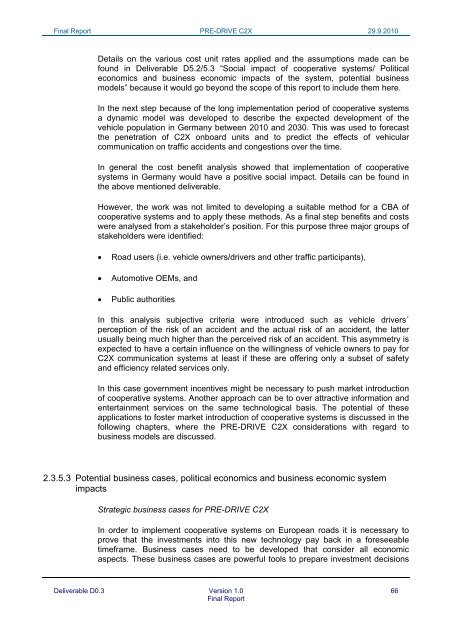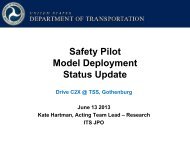PRE-DRIVE C2X Deliverable D0.3 Final report_20100929.pdf
PRE-DRIVE C2X Deliverable D0.3 Final report_20100929.pdf
PRE-DRIVE C2X Deliverable D0.3 Final report_20100929.pdf
Create successful ePaper yourself
Turn your PDF publications into a flip-book with our unique Google optimized e-Paper software.
<strong>Final</strong> Report <strong>PRE</strong>-<strong>DRIVE</strong> <strong>C2X</strong> 29.9.2010<br />
Details on the various cost unit rates applied and the assumptions made can be<br />
found in <strong>Deliverable</strong> D5.2/5.3 “Social impact of cooperative systems/ Political<br />
economics and business economic impacts of the system, potential business<br />
models” because it would go beyond the scope of this <strong>report</strong> to include them here.<br />
In the next step because of the long implementation period of cooperative systems<br />
a dynamic model was developed to describe the expected development of the<br />
vehicle population in Germany between 2010 and 2030. This was used to forecast<br />
the penetration of <strong>C2X</strong> onboard units and to predict the effects of vehicular<br />
communication on traffic accidents and congestions over the time.<br />
In general the cost benefit analysis showed that implementation of cooperative<br />
systems in Germany would have a positive social impact. Details can be found in<br />
the above mentioned deliverable.<br />
However, the work was not limited to developing a suitable method for a CBA of<br />
cooperative systems and to apply these methods. As a final step benefits and costs<br />
were analysed from a stakeholder’s position. For this purpose three major groups of<br />
stakeholders were identified:<br />
<br />
<br />
<br />
Road users (i.e. vehicle owners/drivers and other traffic participants),<br />
Automotive OEMs, and<br />
Public authorities<br />
In this analysis subjective criteria were introduced such as vehicle drivers´<br />
perception of the risk of an accident and the actual risk of an accident, the latter<br />
usually being much higher than the perceived risk of an accident. This asymmetry is<br />
expected to have a certain influence on the willingness of vehicle owners to pay for<br />
<strong>C2X</strong> communication systems at least if these are offering only a subset of safety<br />
and efficiency related services only.<br />
In this case government incentives might be necessary to push market introduction<br />
of cooperative systems. Another approach can be to over attractive information and<br />
entertainment services on the same technological basis. The potential of these<br />
applications to foster market introduction of cooperative systems is discussed in the<br />
following chapters, where the <strong>PRE</strong>-<strong>DRIVE</strong> <strong>C2X</strong> considerations with regard to<br />
business models are discussed.<br />
2.3.5.3 Potential business cases, political economics and business economic system<br />
impacts<br />
Strategic business cases for <strong>PRE</strong>-<strong>DRIVE</strong> <strong>C2X</strong><br />
In order to implement cooperative systems on European roads it is necessary to<br />
prove that the investments into this new technology pay back in a foreseeable<br />
timeframe. Business cases need to be developed that consider all economic<br />
aspects. These business cases are powerful tools to prepare investment decisions<br />
<strong>Deliverable</strong> <strong>D0.3</strong> Version 1.0 66<br />
<strong>Final</strong> Report







